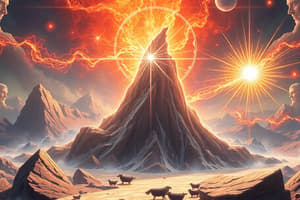Podcast
Questions and Answers
What process involves the splitting of atomic nuclei and releases energy?
What process involves the splitting of atomic nuclei and releases energy?
- Fusion
- Ionization
- Fission (correct)
- Radiation
What is the formula for calculating electric power?
What is the formula for calculating electric power?
- P = V × I (correct)
- P = V / I
- P = V + I
- P = I / V
Which of the following is a key figure known for the theory of relativity?
Which of the following is a key figure known for the theory of relativity?
- Niels Bohr
- James Clerk Maxwell
- Albert Einstein (correct)
- Isaac Newton
In the kinematic equation $s = ut + 0.5at^2$, what does 's' represent?
In the kinematic equation $s = ut + 0.5at^2$, what does 's' represent?
What is the SI unit for measuring mass?
What is the SI unit for measuring mass?
What does the gravitational force depend on?
What does the gravitational force depend on?
Which law states that for every action, there is an equal and opposite reaction?
Which law states that for every action, there is an equal and opposite reaction?
What is the formula for kinetic energy?
What is the formula for kinetic energy?
Which method of heat transfer does NOT require a medium?
Which method of heat transfer does NOT require a medium?
What are transverse waves characterized by?
What are transverse waves characterized by?
In Ohm's Law, what does the equation V = I × R represent?
In Ohm's Law, what does the equation V = I × R represent?
What does the conservation of energy principle state?
What does the conservation of energy principle state?
What does the weak nuclear force primarily affect?
What does the weak nuclear force primarily affect?
Flashcards are hidden until you start studying
Study Notes
Key Concepts in Physics
Fundamental Forces
- Gravitational Force: Attraction between masses, described by Newton's law of universal gravitation.
- Electromagnetic Force: Interaction between charged particles, governed by Coulomb's law.
- Weak Nuclear Force: Responsible for radioactive decay and neutrino interactions.
- Strong Nuclear Force: Binds protons and neutrons in atomic nuclei.
Classical Mechanics
- Newton's Laws of Motion:
- An object in rest or uniform motion stays in that state unless acted upon by a force.
- Force equals mass times acceleration (F = ma).
- For every action, there is an equal and opposite reaction.
- Kinematics: Study of motion without considering forces (displacement, velocity, acceleration).
- Dynamics: Study of forces and their effect on motion.
Energy and Work
- Work: Done when a force causes displacement (W = F × d × cos(θ)).
- Kinetic Energy (KE): Energy of motion (KE = 0.5 × m × v²).
- Potential Energy (PE): Stored energy based on position (PE = m × g × h).
- Conservation of Energy: Total energy in an isolated system remains constant.
Thermodynamics
- Laws of Thermodynamics:
- Energy cannot be created or destroyed.
- Entropy of an isolated system never decreases.
- Absolute zero is unattainable.
- Heat Transfer Methods: Conduction, convection, and radiation.
Waves and Oscillations
- Wave Properties: Wavelength, frequency, amplitude, speed.
- Types of Waves:
- Transverse Waves: Particles move perpendicular to wave direction (e.g., light).
- Longitudinal Waves: Particles move parallel to wave direction (e.g., sound).
- Interference and Diffraction: Phenomena occurring when waves overlap.
Modern Physics
- Quantum Mechanics: Study of particles at atomic and subatomic levels; includes concepts like wave-particle duality and uncertainty principle.
- Relativity:
- Special Relativity: Time and space are relative, and the speed of light is constant.
- General Relativity: Gravity is a curvature of spacetime caused by mass.
Electricity and Magnetism
- Electric Current (I): Flow of electric charge, measured in amperes.
- Ohm's Law: V = I × R (Voltage = Current × Resistance).
- Magnetic Fields: Produced by moving electric charges; described by the right-hand rule.
Atomic and Nuclear Physics
- Atoms: Basic unit of matter, consisting of protons, neutrons, and electrons.
- Nuclear Reactions: Processes such as fission and fusion that release energy.
Astrophysics
- Cosmology: Study of the universe's origin, structure, and evolution.
- Black Holes: Regions in space with gravitational pull so strong that nothing can escape.
Important Formulas
- Kinematic Equations:
- v = u + at
- s = ut + 0.5at²
- v² = u² + 2as
- Energy Equations:
- Total mechanical energy (E) = KE + PE
- Electric Power: P = V × I
Measurement in Physics
- SI Units:
- Length (meter, m)
- Mass (kilogram, kg)
- Time (second, s)
- Electric Current (ampere, A)
- Temperature (kelvin, K)
Key Figures in Physics
- Isaac Newton: Laws of motion and universal gravitation.
- Albert Einstein: Theory of relativity.
- Niels Bohr: Quantum theory of the atom.
Fundamental Forces
- Gravitational force causes attraction between masses, following Newton's law of universal gravitation.
- Electromagnetic force governs interactions between charged particles, as defined by Coulomb's law.
- Weak nuclear force is responsible for processes like radioactive decay and interactions involving neutrinos.
- Strong nuclear force is what holds protons and neutrons together in atomic nuclei.
Classical Mechanics
- Newton's First Law states that an object will remain at rest or in uniform motion unless acted upon by an external force.
- Newton's Second Law asserts that force is equal to mass multiplied by acceleration (F = ma).
- Newton's Third Law highlights the principle that for every action, there is an equal and opposite reaction.
- Kinematics examines motion without reference to forces, focusing on displacement, velocity, and acceleration.
- Dynamics explores the impact of forces on motion.
Energy and Work
- Work is defined as the force applied over a distance, calculated using the formula W = F × d × cos(θ).
- Kinetic energy (KE) represents energy in motion, calculated as KE = 0.5 × m × v².
- Potential energy (PE) is energy stored due to an object's position, expressed as PE = m × g × h.
- The law of conservation of energy states that the total energy in an isolated system remains constant.
Thermodynamics
- The first law of thermodynamics states that energy cannot be created nor destroyed.
- The second law asserts entropy within an isolated system never decreases, signifying disorder's inevitable increase.
- The third law states absolute zero is unattainable.
- Heat transfer occurs via conduction, convection, and radiation methods.
Waves and Oscillations
- Wave properties include wavelength, frequency, amplitude, and speed of propagation.
- Transverse waves have particle motion perpendicular to wave direction (e.g., light waves).
- Longitudinal waves feature particle motion parallel to wave direction (e.g., sound waves).
- Interference and diffraction are phenomena occurring when waves overlap.
Modern Physics
- Quantum mechanics involves studying particles at atomic and subatomic levels, incorporating wave-particle duality and the uncertainty principle.
- Special relativity suggests that measurements of time and space are relative, with the speed of light remaining constant.
- General relativity describes gravity as the curvature of spacetime created by mass.
Electricity and Magnetism
- Electric current (I) is the flow of electric charge, measured in amperes (A).
- Ohm’s Law expresses the relationship between voltage (V), current (I), and resistance (R) using the equation V = I × R.
- Magnetic fields arise from moving electric charges and can be visualized using the right-hand rule.
Atomic and Nuclear Physics
- Atoms are the fundamental units of matter, consisting of protons, neutrons, and electrons.
- Nuclear reactions such as fission and fusion release significant amounts of energy.
Astrophysics
- Cosmology studies the universe's origin, structure, and evolution.
- Black holes are regions with gravitational forces so intense that nothing, not even light, can escape.
Important Formulas
- Kinematics equations include:
- v = u + at
- s = ut + 0.5at²
- v² = u² + 2as
- Total mechanical energy (E) is the sum of kinetic and potential energy (E = KE + PE).
- Electric power is calculated via P = V × I.
Measurement in Physics
- SI units are standardized measurements in physics:
- Length (meter, m)
- Mass (kilogram, kg)
- Time (second, s)
- Electric current (ampere, A)
- Temperature (kelvin, K)
Key Figures in Physics
- Isaac Newton developed the laws of motion and universal gravitation, shaping classical mechanics.
- Albert Einstein is renowned for the theory of relativity, revolutionizing our understanding of time and space.
- Niels Bohr contributed to quantum theory, particularly regarding atomic structure and behavior.
Studying That Suits You
Use AI to generate personalized quizzes and flashcards to suit your learning preferences.




